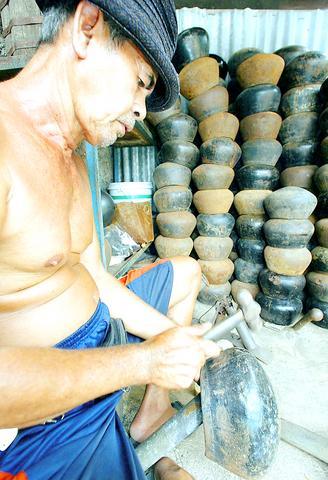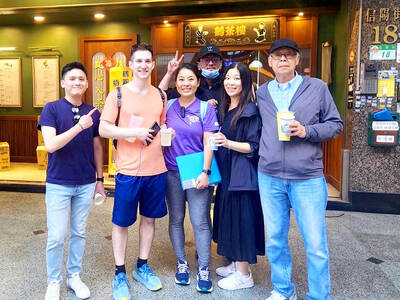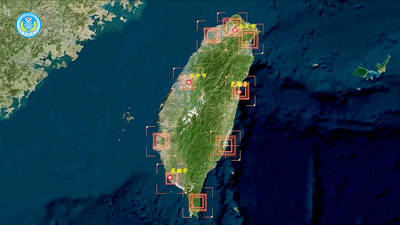Thai artisan Hiran Serseeserm marks the sixth generation of alms bowl makers in his family, and unless efforts are made to revive the ancient but dying Buddhist craft, he could be the last.
In the midst of bustling, overwhelmingly Buddhist Bangkok, a shrinking community of craftspeople hammers out a living preserving the ancient art of making "baat," the alms or monks bowls, synonymous with Buddhist beneficence.
Hiran is a 43-year-old master craftsman and deputy leader of Ban Baat, the once-flourishing Alms Bowl Village which has been whittled down over the decades to a single alley in downtown Bangkok.

PHOTO: AFP
In a ramshackle and cluttered workspace in front of his modest home, Hiran and his sister Mayuree have been firing the bowls out of iron, brass, copper and bronze for the past 30 years.
He said making baat, the bowls used by monks to receive offerings of food, is a treasured art passed down from his ancestors in the Ayutthaya period, an era more than two centuries ago when Buddhist influence reached its apex.
Just a few dozen people pursue the ancient craft these days, as the business which made this community famous a century ago has been nearly snuffed out by aggressive ethnic Chinese merchants who began spinning profits by selling cheaper, machine-made bowls.
The machine-made alms bowls sell for between 120 baht to 400 baht (about US$3 to US$10) while the price for hand-made ones ranges from 500 to 2,000 baht (US$12 to US$290).
"Many of us decided to quit this job because we were making fewer sales and no profits. It wasn't worth doing," Hiran said as he polished one of his latest creations.
When business flourished decades ago, the community of some 100 houses could bang out 100 bowls a day. Today the sales are in single digits, with just three families in Ban Baat keeping the trade in hand-made bowls alive.
Their perseverance, however, has begun to pay off. Business was on the way down for decades, Hiran said, but that was before a district office took notice and decided to preserve and promote Ban Baat as a tourism spot.
Now trade has picked up again, with more people, especially tourists, visiting the community to observe the craft and, more importantly, buy bowls.
"Many foreign tourists now come to watch and buy alms bowls as souvenirs," Hiran said.
The community has been able to lure a new generation of visitors with some welcome publicity from Lonely Planet, the tourism Bible which describes Ban Baat as the last of three such villages established in Bangkok during the reign of King Rama I.
Visiting Italian tourist Anton Fabbri and his girlfriend said they were curious about the bowls after reading how eight pieces of metal symbolizing Buddhism's eightfold path are fused together and then coated with dark lacquer to make the simple but elegant baat.
While machine-made bowls are snapped up at tourist shops, master craftswoman Darisa Buamak, 47, said devout monks throughout Thailand preferred hand-made baat as they better reflected the spirit of Buddhism.
"Many people believe hand-made baat are better because they can retain good spiritual blessings," Darisa said.
Today, with business picking up slightly, Hiran is optimistic that the trade will be passed on to future generations. At 43, he still has several years of bowl-making left, while some people in the community have expressed interest in becoming baat-making apprentices.
"It makes me glad that this cultural heritage will survive," Hiran said.
While the Italian tourists happily walked off with a small handmade bowl to decorate their home, other visitors eyed the 70-year-old, 25cm baat Hiran showed them as a symbol of family pride.
Several people have tried to buy the precious heirloom, whose elegant style is the blueprint for the bowls Hiran makes today, but the craftsman has not budged.
"I won't sell it," a resolute Hiran said. "It was made by my grandfather and it's the last one left."

A vaccine to fight dementia? It turns out there may already be one — shots that prevent painful shingles also appear to protect aging brains. A new study found shingles vaccination cut older adults’ risk of developing dementia over the next seven years by 20 percent. The research, published Wednesday in the journal Nature, is part of growing understanding about how many factors influence brain health as we age — and what we can do about it. “It’s a very robust finding,” said lead researcher Pascal Geldsetzer of Stanford University. And “women seem to benefit more,” important as they’re at higher risk of

Eric Finkelstein is a world record junkie. The American’s Guinness World Records include the largest flag mosaic made from table tennis balls, the longest table tennis serve and eating at the most Michelin-starred restaurants in 24 hours in New York. Many would probably share the opinion of Finkelstein’s sister when talking about his records: “You’re a lunatic.” But that’s not stopping him from his next big feat, and this time he is teaming up with his wife, Taiwanese native Jackie Cheng (鄭佳祺): visit and purchase a

April 7 to April 13 After spending over two years with the Republic of China (ROC) Army, A-Mei (阿美) boarded a ship in April 1947 bound for Taiwan. But instead of walking on board with his comrades, his roughly 5-tonne body was lifted using a cargo net. He wasn’t the only elephant; A-Lan (阿蘭) and A-Pei (阿沛) were also on board. The trio had been through hell since they’d been captured by the Japanese Army in Myanmar to transport supplies during World War II. The pachyderms were seized by the ROC New 1st Army’s 30th Division in January 1945, serving

The People’s Republic of China (PRC) last week offered us a glimpse of the violence it plans against Taiwan, with two days of blockade drills conducted around the nation and live-fire exercises not far away in the East China Sea. The PRC said it had practiced hitting “simulated targets of key ports and energy facilities.” Taiwan confirmed on Thursday that PRC Coast Guard ships were directed by the its Eastern Theater Command, meaning that they are assumed to be military assets in a confrontation. Because of this, the number of assets available to the PRC navy is far, far bigger